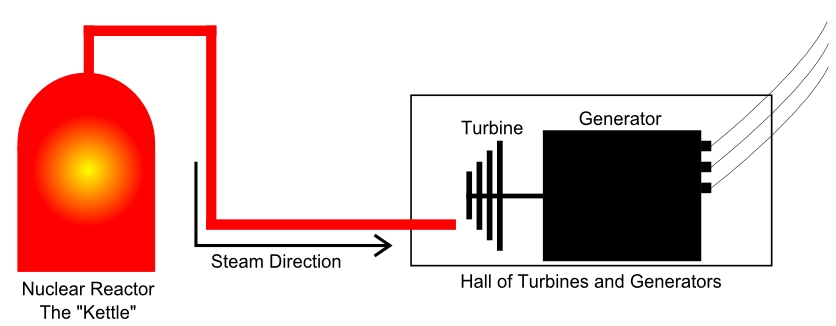
Home Page Previous Page Next Page
The Soviet Union and the nuclear power plants in 1986
In 1986, the Soviet nuclear program was in full swing. At the time of the accident, they had 43 reactors, providing a power of 26 billion watts (26 gigawatts). In addition, 34 reactors were under construction, to provide additional 36 billion watts (36 gigawatts). It is interesting to note that, already at that time, the Soviets turned to the pressurized water reactors (PWR) rather than the RBMK. Maybe it was already an admission of the obsolescence of the RBMK reactor...
In most power plants, the water is heated and converted to steam and this steam activates the turbogenerators which produce the electricity. The fossil fuel power plants generate heat by burning coal, oil or natural gas. In a nuclear power plant, it is the fission of uranium atoms which provides the heat required for the production of the steam which drives the generators.
Several types of commercial reactors are used. The most common is comprised of a heavy steel vessel containing the core of the reactor. The core contains the uranium fuel. The nuclear fuel is contained in cylindrical ceramic pellets about one inch (2.5 cm) in diameter which are sealed into long metal tubes called fuel tubes. The tubes are combined to form a fuel assembly. The fuel assemblies are the heart of the reactor.
In the fission process, certain heavy elements, such as certain forms of uranium, are broken when a neutron collides with them. When they break, the uranium nuclei release energy as kinetic energy (heat) and radiation. The process does not release only energy, but also additional neutrons which may be used to break other uranium nuclei, thus starting a chain reaction.
How a nuclear reactor works?
In summarizing quickly, a nuclear reactor is a kettle which, making boil water, thus produces steam and the steam is then used to drive the turbines that will spin the alternators to produce electricity. A nuclear power plant operates exactly in the same way than a "conventional" power plant, except that the energy to produce steam is supplied by the nuclear fission rather than coal, gas or fuel oil.

A very simplified diagram of a nuclear power plant
Overall, all reactors operate on the same principle, quite simple indeed: the neutrons break uranium atoms. This action produces heat and releases new neutrons which will help to maintain the reaction. The heat produced during the reaction heats water to boil and steam is generated, and the energy of this steam will drive a turbine coupled to a generator that produces electricity.
The high-speed of the neutrons does not allow a chain reaction. Due to their high speed, the neutrons would have little chance to reach and break the nucleus of uranium atoms. Thus, in all reactors, an element called "moderator" is used, whose purpose is to slow the neutrons in order to allow them to reach their target, the nucleus of the atoms of uranium. This moderator may be the light water (H2O, our domestic water), heavy water (2H2O or D2O, a variety of water, with a high proportion of deuterium, an hydrogen isotope with a density of about 1.1), or the graphite in the case of the RBMK reactors. Almost all Western reactors use the light-water or the heavy water.
Of course, we need to control the reaction in the "kettle." A reactor is stable when it consumes as many neutrons as it produces. If the reactor needs more neutrons than it produces, it will slow down and stop, and if it produces more neutrons than it consumes, the power will increase, since more atoms of uranium will be broken. To regulate the flow of neutrons, the "control rods", made of a strongly neutron absorbing material such as boron are used. When the control rods are inserted in the reactor core, they absorb neutrons which break fewer atoms of uranium and the power decreases. Conversely, if the control rods are withdrawn from the reactor, fewer neutrons are absorbed and the power increases.